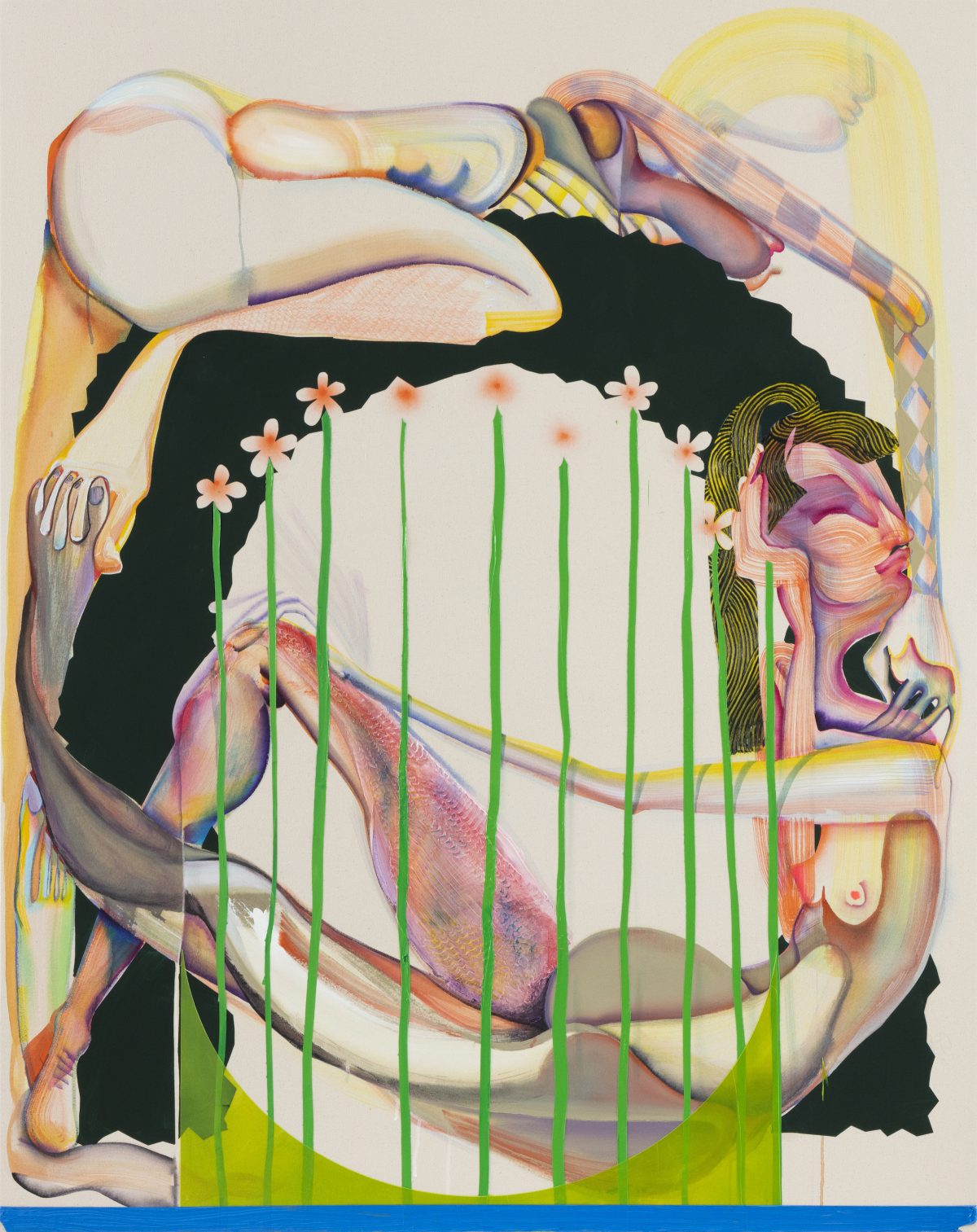
CHICAGO — If there were an equivalent to Mannerism in contemporary painting, Christina Quarles might be the Pontormo of 2021. She elongates, distorts, contorts, and flays the figure. Her paintings show off virtuosity in the way 16th-century Mannerist painters blithely tucked emotion into artifice in exaggerated, twisty, climactic altar pieces.
The Los Angeles artist’s largest show to date, currently at the Museum of Contemporary Art Chicago, presents 24 paintings in two large rooms, organized thematically with single figure works, then double, then multiple. The work dates from 2017 to 2020.

Quarles is queer, cisgender, and light-skinned, with a Black father and white mother. These multi-situated details bear mentioning because the artist says her paintings are specifically about gender and race. In a recent Art News interview, Quarles explained that, “The basis of the work is trying to get at what it is to be in a racialized body, to be in a gendered body, to be in a queer body, really to be in any body and the confusing place that that actually is with knowing yourself.”
If these identifiers are truly in the paintings, they float in coded languages. The paintings feel as if they are ambiguously about painting itself, with the figures serving a supporting role. The bodies are formed with breezy brush marks, patterns, dissolving washes that fill and deteriorate, limbs that don’t always support the formation of actual feet. She implies that we are complex liquid beings who morph according to our surroundings. Boundaries dissolve as Quarles grinds up the fixed binaries of Black/white or male/female and then reconstitutes definitions of wholeness in a flurry of languages. Like a Tower of Babel of mark making, a pattern or texture might hold some associative resonance but translation is never assured.

Quarles, who has an undergraduate philosophy degree in critical race theory from Hampshire College and an MFA from Yale MFA, begins her paintings by spontaneously making marks. Once she sees a direction, she photographs the painting and uses Adobe Illustrator to add planes and patterns that might get printed as stencils. These mechanics are seamless on the canvas.
Each painting is composed of bodies that intimately touch, stretch, or sexually entwine via loose, elongated limbs. The mood is tense and hard to decipher. In “Tha Color of Tha Sky (Magic Hour)” (2017), salmon and purples flirt with yellow and gray gradients, infused with David Hockney light, but the downward momentum of attenuated limbs and drips pulls with weighty materiality, penetrating geometric planes or boundaries. The figures stay faceless, angular, remote: not individuals but disordered forms that coalesce awkwardly with their surroundings, squeezing into the picture plane. In “Peer Amid (Peered Amidst),” (2019), a gooey cubist pile of three bodies torques over a black silhouetted shadow. Compression, strength, and exhaustion tangle in a painterly crescendo of physical gestures. As a viewer, you approach these works by trying to decipher a narrative, but inevitably get sidetracked into oohing and aahing over the way Quarles makes perfect raised lines of acrylic paint (hair), scratches in a wavy pattern, changes the color of a drip halfway down, layers transparencies, whips a simple line into a claw-like hand, contours moon shaped buttocks, and turns breasts into stalactites or gourds. The paintings are best when infused with a bit of playfulness, such as “Change Comin’ Round Tha Bend (Right Round, Right Round)” (2019), with a swirl of bodies anchored by a foreground of childlike daisies.

The back wall of the exhibition is painted bright pink and holds one of the few departures from the demands of the many (too many) paintings. Here a line of small pen drawings at first looks like sketches for future works. But then one sees the precision, the control mirrored in Quarles’ paintings. In the middle of the largest gallery are three 12-foot tall free-standing panels covered with unstretched canvas. Named after the 1974 Pilot song lyric, “Never Believe It’s Not so (Never Believe / It’s Not So)” (2019), the installation lets us physically walk through the work.
Filtered through the past decade of amplified debates about race and gender, Quarles’ work feels like a kind of contemporary Mannerism or a refinement of earlier, more direct identity art. Her figures express the exhaustion and triumph of wrestling ideas about race, privilege, intimacy, and queer identity to the surface. It is a lot to accomplish.
Christina Quarles continues at the Museum of Contemporary Art, Chicago (220 E Chicago Ave, Chicago) through January 16, 2022. The exhibition was curated by Grace Deveney and Jack Schneider.
0 Commentaires